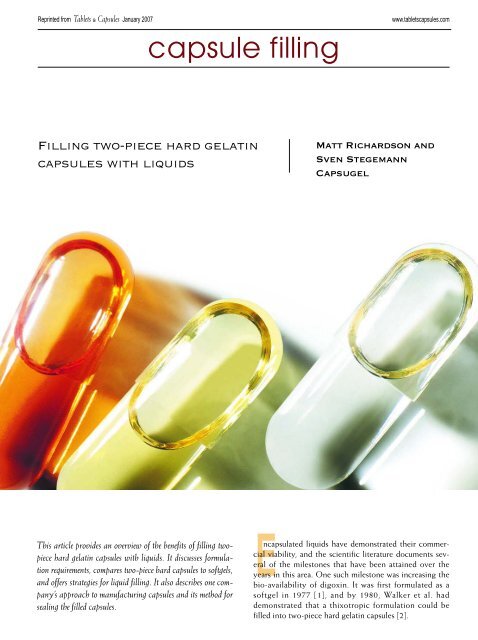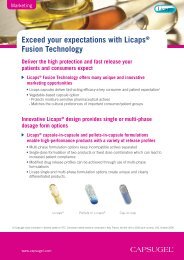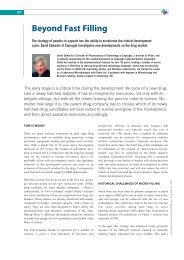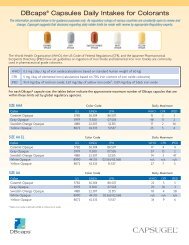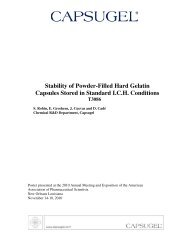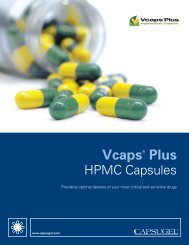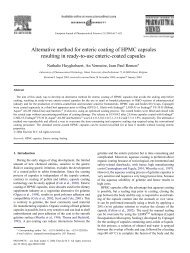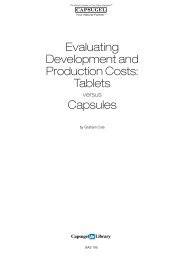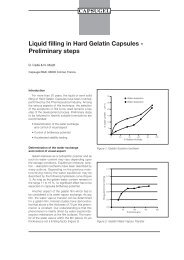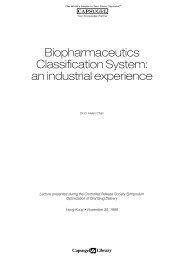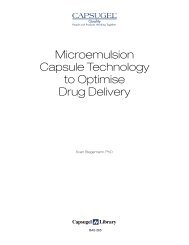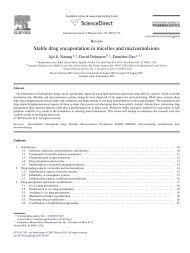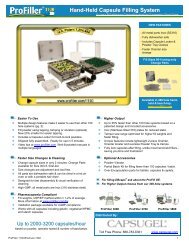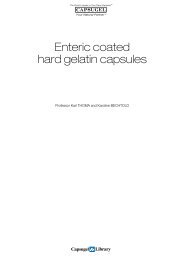Filling two-piece hard gelatin capsules with liquids - Capsugel
Filling two-piece hard gelatin capsules with liquids - Capsugel
Filling two-piece hard gelatin capsules with liquids - Capsugel
You also want an ePaper? Increase the reach of your titles
YUMPU automatically turns print PDFs into web optimized ePapers that Google loves.
Reprinted from Tablets & Capsules January 2007<br />
capsule filling<br />
www.tablets<strong>capsules</strong>.com<br />
<strong>Filling</strong> <strong>two</strong>-<strong>piece</strong> <strong>hard</strong> <strong>gelatin</strong><br />
<strong>capsules</strong> <strong>with</strong> <strong>liquids</strong><br />
Matt Ric<strong>hard</strong>son and<br />
Sven Stegemann<br />
<strong>Capsugel</strong><br />
This article provides an overview of the benefits of filling <strong>two</strong><strong>piece</strong><br />
<strong>hard</strong> <strong>gelatin</strong> <strong>capsules</strong> <strong>with</strong> <strong>liquids</strong>. It discusses formulation<br />
requirements, compares <strong>two</strong>-<strong>piece</strong> <strong>hard</strong> <strong>capsules</strong> to softgels,<br />
and offers strategies for liquid filling. It also describes one company’s<br />
approach to manufacturing <strong>capsules</strong> and its method for<br />
sealing the filled <strong>capsules</strong>.<br />
Encapsulated <strong>liquids</strong> have demonstrated their commercial<br />
viability, and the scientific literature documents several<br />
of the milestones that have been attained over the<br />
years in this area. One such milestone was increasing the<br />
bio-availability of digoxin. It was first formulated as a<br />
softgel in 1977 [1], and by 1980, Walker et al. had<br />
demonstrated that a thixotropic formulation could be<br />
filled into <strong>two</strong>-<strong>piece</strong> <strong>hard</strong> <strong>gelatin</strong> <strong>capsules</strong> [2].
In 1981, Sandoz brought to market Sandimmun, a<br />
coarse emulsion of cyclosporine A [3]. But that product’s<br />
variability in delivering the active pharmaceutical ingredient<br />
(API) led to its reformulation into a self-emulsifying<br />
drug delivery system (SEDDS) of cyclosporine A in<br />
1988, and it was marketed as Neoral [4, 5]. In 1995,<br />
Bristol-Myers Squibb introduced a thixotropic, sustainedrelease<br />
formulation (captopril) as a liquid-filled <strong>two</strong>-<strong>piece</strong><br />
<strong>hard</strong> capsule [6,7].<br />
Likewise today, research and development efforts focus<br />
on the many advantages that <strong>liquids</strong> can provide to challenging<br />
compounds. In fact, many pharmaceutical companies<br />
dedicate research groups to investigating liquid formulations.<br />
Usually the goal is to overcome poor aqueous<br />
solubility to improve oral bio-availability; poor content<br />
uniformity of low-dose drugs; and safety concerns when<br />
handling highly potent APIs, such as cytotoxins.<br />
While there are several new methods for delivering<br />
APIs (i.e., transdermal, intranasal, and inhaled technologies),<br />
the number of products on the market that use these<br />
technologies is small, and the preferred route of delivery<br />
remains solid oral dosage forms. That explains why the<br />
drive to encapsulate <strong>liquids</strong> in <strong>two</strong>-<strong>piece</strong> <strong>hard</strong> <strong>gelatin</strong> <strong>capsules</strong><br />
is increasing: Companies want to expand the number<br />
of products they can offer in solid dosage form, and<br />
encapsulating <strong>liquids</strong> is sometimes the best or only option.<br />
The role of <strong>liquids</strong> in today’s formulations<br />
Liquid formulation strategies can address problems in<br />
many areas [8]. The introduction of new drug discovery<br />
technologies, such as high-throughput screening and<br />
combinatorial chemistry, has generated libraries of new<br />
compounds <strong>with</strong> higher molecular weight and greater lipophilicity<br />
than compounds discovered using traditional<br />
methods [9].<br />
Therefore, it is<br />
not surprising<br />
that, of all the<br />
applications for<br />
liquid-filled <strong>two</strong><strong>piece</strong><br />
<strong>hard</strong> <strong>capsules</strong>,<br />
increasing<br />
the bio-availability<br />
of poorly soluble<br />
compounds<br />
attracts the most<br />
interest.<br />
Lipophilic solutions<br />
[10, 11]<br />
and solid dispersions<br />
[10, 12] are<br />
<strong>two</strong> means of<br />
dealing <strong>with</strong><br />
poorly soluble<br />
compounds.<br />
Excipient suppliers<br />
now provide<br />
a host of liquid<br />
Dissolution (%)<br />
100<br />
80<br />
60<br />
40<br />
20<br />
Figure 1<br />
and semi-solid excipients to help solubilize APIs for<br />
improved delivery. The importance of these excipients is<br />
evident in Figure 1, which compares the in vitro dissolution<br />
profiles of triamterene when formulated <strong>with</strong> different<br />
solubilizing excipients [13]. Formulating drug compounds<br />
in liquid or semi-solid excipients is also used to<br />
target lymphatic transport [14] or to circumvent the<br />
impact of transporters [15] and metabolizing enzymes<br />
[16] in the GI tract.<br />
The major technique for enhancing bio-availability is<br />
SEDDS [10, 16, 17, 18], a technique that uses lipophilic,<br />
pre-concentrated solutions of the API and excipients<br />
(typically a liquid carrier, a surfactant, and a co-surfactant).<br />
When delivered to the aqueous environment of the<br />
GI tract, the SEDDS spontaneously forms an oil-water<br />
emulsion that contains particles smaller than 200<br />
nanometers. Selecting compounds that are candidates for<br />
SEDDS requires determining the essential properties of<br />
the API. Benameur provided an excellent summary of the<br />
properties to focus on [19].<br />
Low-dose compounds can also benefit from liquid<br />
encapsulation. When a true solution exists, the API is<br />
inherently uniformly dispersed throughout the formulation<br />
[20]. And because filling <strong>two</strong>-<strong>piece</strong> <strong>hard</strong> <strong>capsules</strong><br />
<strong>with</strong> <strong>liquids</strong> has been demonstrated to provide good<br />
accuracy [21], proper dosage through a simple formulation<br />
is ensured. This is especially important when formulating<br />
<strong>with</strong> high-potency compounds because the dose is<br />
often small. Furthermore, when a high-potency API<br />
and/or cytotoxic compound is dissolved in liquid, dusting<br />
diminishes drastically, which decreases the risks of crosscontamination<br />
and employee exposure. Bowtle demonstrated<br />
this by swab-testing capsule bushings on a<br />
machine that filled <strong>liquids</strong> into <strong>hard</strong> <strong>capsules</strong> [22].<br />
Comparison of dissolution profiles of triamterene formulated <strong>with</strong> different<br />
solubilizing excipients [13]<br />
0<br />
0 20 40 60<br />
Time (min)<br />
API<br />
PEG 1000<br />
PEG 1500<br />
PEG 4000<br />
PEG 6000<br />
Gelucire 44/14<br />
Low-meltingpoint<br />
compounds<br />
are also suitable<br />
candidates for<br />
liquid filling. The<br />
low-meltingpoint<br />
drug can<br />
be dissolved in a<br />
single liquid vehicle<br />
and encapsulated.<br />
When<br />
these types of<br />
compounds are<br />
formulated as a<br />
powder for encapsulation<br />
or<br />
compression into<br />
a tablet, they<br />
typically require<br />
high excipient<br />
loads to process<br />
reliably.<br />
There is significant<br />
prece-
dence to the encapsulation of <strong>liquids</strong>. Technology to assist<br />
both research and manufacturing groups <strong>with</strong> liquid filling<br />
has evolved from difficult-to-operate, capital-intensive<br />
equipment to the point that small, lab-scale liquid filling<br />
and sealing units are commercially available. Formulation<br />
technology and equipment have evolved in step <strong>with</strong> the<br />
pharmaceutical industry’s need to deliver the poorly soluble<br />
compounds that have become predominant in product<br />
pipelines.<br />
Assessing the compatibility of fill materials<br />
The properties of the API dictate whether it is a good<br />
candidate for liquid filling. Next, suitable excipients are<br />
evaluated, <strong>with</strong> an understanding that neither the API nor<br />
the excipients should cause the <strong>gelatin</strong> shell to gain or lose<br />
excessive moisture, which can cause the shell to lose its<br />
mechanical strength. All substances must also be chemically<br />
compatible <strong>with</strong> <strong>gelatin</strong> [23].<br />
To maintain flexibility, the capsule shell must retain a<br />
moisture content of 13 to 16 percent. Below that range <strong>capsules</strong><br />
become brittle and are prone to breakage. Above that<br />
range the <strong>capsules</strong> may deform. To measure the moisture<br />
exchange between the fill material and the shell, fill the<br />
<strong>capsules</strong> <strong>with</strong> the product in question and store them at different<br />
levels of relative humidity (RH) (i.e., 2.5, 10, 30, 50,<br />
and 60 percent) for 2 weeks. During that period, the water<br />
exchange across the range of RHs should not exceed ±2<br />
percent. Fill materials that exchange more than ±2 percent<br />
moisture compared to empty shells stored under the same<br />
conditions are not suitable for liquid filling. The capsule’s<br />
mechanical resistance must be checked in relation to moisture<br />
content. This entails storing the filled <strong>capsules</strong> for 1<br />
week at different RHs and then testing them for resistance<br />
to breakage and deformation.<br />
Chemical compatibility of the fill material <strong>with</strong> the<br />
<strong>gelatin</strong> shell is also important. For instance, if the fill material<br />
causes the protein chains of the <strong>gelatin</strong> to cross-link,<br />
there may be a delay in dissolution. One method of monitoring<br />
cross-linking is to first store the fill material inside<br />
the <strong>hard</strong> <strong>gelatin</strong> <strong>capsules</strong> under ICH accelerated storage<br />
conditions (40°C at 75 percent RH), and then replace the<br />
fill material <strong>with</strong> acetaminophen. Next, conduct a dissolution<br />
test according to USP guidelines to compare the dissolution<br />
profiles of the filled and unfilled <strong>capsules</strong> stored at<br />
the accelerated conditions. Table 1 lists some liquid and<br />
semi-solid excipients that are compatible <strong>with</strong> <strong>hard</strong> <strong>gelatin</strong><br />
<strong>capsules</strong>.<br />
Hard <strong>capsules</strong> vs. softgels<br />
No discussion of filling <strong>hard</strong> <strong>gelatin</strong> <strong>capsules</strong> <strong>with</strong> <strong>liquids</strong><br />
is complete <strong>with</strong>out a comparison to soft <strong>gelatin</strong> <strong>capsules</strong>.<br />
There are significant differences between the<br />
dosage forms, and it’s sometimes helpful to consider them<br />
complementary rather than competitive. Actually, the<br />
formulation often dictates the capsule type, but in cases<br />
where the formulation allows a choice between dosage<br />
forms, <strong>hard</strong> <strong>capsules</strong> have several advantages over softgels<br />
because they are less complex to manufacture.<br />
First, soft <strong>gelatin</strong> contains a significant amount of plasticizer,<br />
usually glycerol or sorbitol, while the <strong>gelatin</strong> used<br />
in <strong>hard</strong> <strong>capsules</strong> contains no plasticizer. Plasticizers<br />
impart elasticity to the <strong>gelatin</strong> shell and allow it to<br />
accommodate a wide range of hydrophilic excipients, but<br />
their presence raises the issue of component migration.<br />
For example, if the plasticizer solubilizes the compounds<br />
of the formulation, those compounds can migrate into<br />
the soft <strong>gelatin</strong> shell. (The large amount of water in the<br />
<strong>gelatin</strong> during softgel manufacture may also play some<br />
role in this migration.) Conversely, the plasticizer might<br />
migrate into the formulation.<br />
Furthermore, soft <strong>gelatin</strong> may expose the fill material to<br />
more oxygen than a <strong>hard</strong> capsule would because the plasticizers<br />
in soft <strong>gelatin</strong> create channels that are larger than<br />
those in <strong>hard</strong> <strong>gelatin</strong>. See Figure 2. Greater exposure to<br />
air increases the potential for oxidizing (degrading) the<br />
fill material. In addition to an inherently lower oxidation<br />
potential, <strong>hard</strong> <strong>gelatin</strong> <strong>capsules</strong> can be filled in a nitrogen<br />
environment<br />
to further protect<br />
the contents. The<br />
smaller channels<br />
in <strong>hard</strong> <strong>gelatin</strong><br />
<strong>capsules</strong> also<br />
mask the offtastes<br />
and odors<br />
associated <strong>with</strong><br />
pharmaceutical<br />
formulations better<br />
than softgels<br />
can.<br />
Table 1<br />
Liquid excipients for <strong>hard</strong> <strong>gelatin</strong> <strong>capsules</strong><br />
Lipophilic vehicles<br />
Refined oils:<br />
Arachis oil, Castor oil, Cottonseed oil, Corn oil,<br />
Olive oil, Sesame oil, Soybean oil, Sunflower oil<br />
Medium chain triglycerides/esters:<br />
Akomed E, Akomed R, Labrafac CC, Labrafac PG<br />
Lauroglycol FCC, Miglyols (810, 812, 829) Softisan 645<br />
Semi-solid lipophilic vehicles<br />
Aerosil, Cetosteryl alcohol, Cetyl alcohol, Gelucires (33/01, 39/01,<br />
43/01), Steryl alcohol, Softisans (100, 142, 378, 649), Glyceryl<br />
palmitostearate, Hydrogenated refined oils<br />
Solubilizing agents, surfactants, and emulsifiers<br />
Capryol 90, Cremophor RH 40, Gelucires (44/14, 50/13), PEGs MW ><br />
4000, Tween 80, Softigens (701, 767), Lauroglycol 90, Labrafils<br />
(M 1944 CS, M 2125 CS)<br />
Excipients incompatible at 100%<br />
MCMs (Akoline, Capmul, Imwitor 308), PEGs MW < 4000, Glycerin,<br />
Propylene glycol, Transcutol P, Span 80, Ethanol<br />
Figure 2<br />
Soft <strong>gelatin</strong> (right) has larger channels<br />
than <strong>hard</strong> <strong>gelatin</strong>, as shown in these<br />
freeze etchings taken from a<br />
scanning electron microscope<br />
(1.6 x 10 -6 magnification).
Manufacturing softgels is also very different from filling<br />
<strong>hard</strong> <strong>gelatin</strong> <strong>capsules</strong> <strong>with</strong> <strong>liquids</strong>. Empty <strong>hard</strong> <strong>gelatin</strong><br />
<strong>capsules</strong> are purchased separately and then filled. With<br />
softgels, <strong>two</strong> ribbons of <strong>gelatin</strong> come together in a die to<br />
form the capsule, which is filled and sealed in one continuous<br />
process. Furthermore, the softgel process cannot<br />
accept fill materials that exceed 35°C. And formulations<br />
containing large particles or fibrous materials are not<br />
good candidates for softgels because they may prevent a<br />
secure seal when the <strong>two</strong> sides of the shell come together.<br />
Another potential drawback: Liquid formulations may<br />
require a formulation of the softgel shell itself. If this is<br />
contracted out to a softgel manufacturer, intellectual<br />
property rights to the shell typically remain <strong>with</strong> the contract<br />
manufacturer. That limits the possibility of changing<br />
to another contractor. In general, softgel manufacture<br />
requires expensive equipment and is a labor-intensive<br />
process. For the development of soft <strong>gelatin</strong> <strong>capsules</strong>,<br />
contract manufacturers often require several kilograms of<br />
formulation, which can be challenging in the early development<br />
phase when large amounts of the drug substance<br />
are difficult to acquire. With <strong>hard</strong> <strong>gelatin</strong> <strong>capsules</strong>, smallscale<br />
filling <strong>with</strong> only a few grams of formulation can be<br />
done in-house <strong>with</strong> lab-scale equipment. No lab-scale<br />
(benchtop) equipment for softgel production exists today.<br />
volume and other properties of <strong>two</strong>-<strong>piece</strong> <strong>capsules</strong> for liquid<br />
filling.<br />
A brief comparison of sealing methods<br />
Once closed, the capsule must be sealed to prevent<br />
leaks and tampering. A hydro-alcoholic fusion process<br />
(described in the USP’s capsule monograph) is one<br />
method of sealing [25]. See Figure 4.<br />
This fusion process begins <strong>with</strong> an application of less<br />
than 50 microliters of sealing solution to the cap-body<br />
interface. The solution penetrates the overlapping cap<br />
and body by capillary action, while a vacuum removes<br />
any excess sealing fluid from the capsule. Next, gentle<br />
application of warm (40° to 60°C) air fuses the <strong>gelatin</strong> of<br />
the cap and body together and evaporates the sealing<br />
solution. The entire process takes less than 1 minute and<br />
transforms the <strong>two</strong>-<strong>piece</strong> <strong>hard</strong> capsule into a leak-free<br />
dosage unit. Once sealed, the capsule meets tamper-evidence<br />
guidelines since it cannot be opened <strong>with</strong>out visibly<br />
altering it.<br />
Figure 3<br />
Two-<strong>piece</strong> capsule for liquid fills [24]<br />
A capsule for <strong>liquids</strong><br />
While many companies are opting for liquid encapsulation<br />
today, it isn’t exactly a new trend. In 1998,<br />
<strong>Capsugel</strong> launched a capsule specially designed for liquid<br />
and semi-solid fills [24]. See Figure 3. This capsule is<br />
longer than standard <strong>capsules</strong>, so that when the capsule<br />
body and cap are fully joined, the top of the capsule<br />
body’s wall contacts the interior of the cap. This provides<br />
the primary barrier to prevent the liquid fill from escaping.<br />
(It is essential to keep the area of the cap-body interface<br />
uncontaminated by fill material. Otherwise, it is virtually<br />
impossible to seal the capsule.) To further prevent<br />
or reduce leakage and contamination at the cap-body<br />
interface, the capsule has no side air vents, which are typical<br />
of <strong>capsules</strong> used in high-speed powder filling. The<br />
capsule is normally filled to no more than 90 percent of<br />
its volume to minimize the chance of the liquid fill contaminating<br />
the cap-body interface. Table 2 lists available<br />
Table 2<br />
Size and volume of <strong>two</strong>-<strong>piece</strong> <strong>gelatin</strong> <strong>capsules</strong> for liquid filling [24]<br />
Size 00el 0 0el 0 1 2 3 4<br />
Weight (mg) 130 118 110 96 76 61 48 38<br />
Tolerance (mg) ±10 ±7 ±7 ±6 ±5 ±4 ±3 ±3<br />
Volume (ml) 1.02 0.91 0.7 0.68 0.5 0.37 0.3 0.21<br />
Available Volume (ml) 0.89 0.82 0.61 0.59 0.43 0.33 0.26 0.18
Figure 4<br />
Capsule sealing using a hydro-alcohol solution [25]<br />
Sealing fluid is sprayed onto<br />
cap-body interface.<br />
Capillary action draws fluid<br />
up between the cap and<br />
body. Vacuum removes<br />
excess fluid.<br />
Applying gentle heat<br />
completes melting and<br />
fusion to form a leak-free,<br />
tamper-evident seal.<br />
Another method entails banding the cap-body interface<br />
<strong>with</strong> a thin strip of <strong>gelatin</strong>. Banding, however,<br />
involves several additional tasks compared <strong>with</strong> hydroalcoholic<br />
sealing. First, someone must prepare the <strong>gelatin</strong><br />
bath, and its viscosity must be checked continuously.<br />
Operators must also address the risk of microbiological<br />
contamination associated <strong>with</strong> warm liquid <strong>gelatin</strong>.<br />
Furthermore, the <strong>gelatin</strong> band can cause physical defects<br />
in the capsule: Bubbles may form in the <strong>gelatin</strong> band or<br />
the <strong>capsules</strong> may take on a “banana” shape. The deformation<br />
usually occurs when the warm band of <strong>gelatin</strong> cools<br />
and the <strong>capsules</strong> are subjected to a long drying cycle.<br />
The machine at left fills and seals as many as 1,200 <strong>capsules</strong> per hour [26].<br />
The machine at right is a commercial-scale capsule sealer [27]. It works in<br />
tandem <strong>with</strong> a liquid capsule filler.<br />
The photos above show liquid filling and sealing<br />
equipment. The GMP-compliant lab-scale filler-sealer<br />
fills and seals as many as 1,200 <strong>capsules</strong> (size 00el to 4)<br />
per hour [26]. It is well suited to conducting R&D and<br />
making early clinical trial supplies. It can handle<br />
thixotropic and hot-melt fill materials. The other<br />
machine is a commercial-scale dedicated capsule sealer<br />
that links to high-speed filling machines via a belt conveyor<br />
[27]. It seals as many as 60,000 <strong>capsules</strong> per hour<br />
and has proven itself in both the pharmaceutical and the<br />
dietary-supplement markets [28].<br />
Conclusion<br />
Liquid formulations filled into <strong>two</strong>-<strong>piece</strong> <strong>hard</strong> <strong>capsules</strong><br />
have attracted substantial interest in the pharmaceutical<br />
industry over the last decade. Today’s challenges in product<br />
development due to the poor aqueous solubility and<br />
high potency of the new molecular entities are being<br />
addressed by several development groups that are<br />
focused on liquid or semi-solid formulations.<br />
With today’s equipment, filling and sealing these formulations<br />
into <strong>two</strong>-<strong>piece</strong> <strong>hard</strong> <strong>gelatin</strong> <strong>capsules</strong> can be<br />
done easily in-house. The processes have also been<br />
proven to be commercially viable for in-house manufacturing.<br />
Several pharmaceutical products currently under<br />
development are expected to reach the market <strong>with</strong>in the<br />
coming years, increasing the number of commercial<br />
products using a liquid-filled and sealed capsule. T&C<br />
References<br />
1. Ghirardi et al., Bioavailability of digoxin in a new<br />
soluble pharmaceutical Formulation in Capsules, J Pharm<br />
Sci, 66 (2), 1977, 267-269.<br />
2. Walker et al., The filling of molten and thixotropic<br />
formulations into <strong>hard</strong> <strong>gelatin</strong> <strong>capsules</strong>. J. Pharm<br />
Pharmacology, 32, 1980, 389-393.<br />
3. Friman and Backman, A new microemulsion formulation<br />
of cyclosporine, Drug Disposit, 30 (3), 1996, 181-193.<br />
4. Kovarik et al., Reduced inter- and intra-individual<br />
variability in cyclosporine pharmacokinetics from a<br />
microemulsion formulation. J Pharm Sci, 83 (3), 1994,<br />
444-446.<br />
5. Freeman et al., Pharmacokinetics of a new oral formulation<br />
of cyclosporine in liver transplant recipients.<br />
Ther Drug Monit 17 (3), 1995, 213-216.<br />
6. Seta et al., Design and preparation of captopril sustained-release<br />
dosage forms and their biopharmaceutical<br />
properties. Int J Pharm 41, 1988, 245-254.<br />
7. Seta et al., Preparation and pharmacological evaluation<br />
of captopril sustained-release dosage forms using oily<br />
semisolid matrix. Int J Pharm 41, 1988, 255-262.<br />
8. Cole, E.T., Liquid-filled <strong>hard</strong> <strong>gelatin</strong> <strong>capsules</strong>.<br />
Pharm Tech Int, 1989.<br />
9. Lipinski C. Drug-like properties and the causes of<br />
poor solubility and poor permeability. J Pharmacol<br />
Toxicol Meth 44, 235-249, 2000.<br />
10. Joshi and Shah, Review of lipids in pharmaceutical<br />
drug delivery systems, Am Pharm Rev, 8 (3), 2005, 70-78<br />
and references therein.<br />
11. Podczeck and Jones, editors, Pharmaceutical<br />
Capsules, 2nd ed., Pharmaceutical Press, 2004, 184-189.<br />
12. Sharma, P.K, et al., Current trends in solid dispersion<br />
techniques, Drug Delivery Technology, 6 (5), 2006<br />
and references therein.
13. Dordunoo et al., Drug development and industrial<br />
pharmacy, 17 (12), 1991, 1685-1713.<br />
14. Griffin and O’Driscoll, A comparison of intestinal<br />
lymphatic transport and systemic bioavailability of<br />
saquinavir from three lipid-based formulations in the<br />
anaesthetized rat model, J Pharm Pharmacol, 58, 2006,<br />
917-925.<br />
15. Martin-Facklam, et al., Dose-dependent increase of<br />
saquinavir bioavailability by the pharmaceutical aid cremophor<br />
EL, Br J Clin Pharmacol, 53, 2002, 576-581.<br />
16. Gao and Morozowich, Development of supersaturatable<br />
self-emulsifying drug delivery system formulations<br />
for improving the oral absorption of poorly soluble drugs,<br />
Expert Opin Drug Deliv, 3 (1), 2006, 97-110.<br />
17. Stegemann, S., Microemulsion capsule technology<br />
to optimize drug delivery, <strong>Capsugel</strong> Library, BAS 265.<br />
18. Cole, E.T,. Liquid-filled <strong>hard</strong>-<strong>gelatin</strong> <strong>capsules</strong>,<br />
<strong>Capsugel</strong> Library, BAS 137.<br />
19. Benameur, H., Liquid and semi-solid formulations<br />
for enhancing oral absorption, Bulletin Technique<br />
Gattefossé, Number 99, 2006.<br />
20. Walker, et al., The filling of molten and<br />
thixotropic formulations into <strong>hard</strong> <strong>gelatin</strong> <strong>capsules</strong>. J<br />
Pharm Pharmacology 32, 1980, 389-393.<br />
21. Cade et al., Liquid filled and sealed <strong>hard</strong> <strong>gelatin</strong><br />
<strong>capsules</strong>, Acta Pharm Technol 33 (2), 1987, 97-100.<br />
22. Cole, E.T., Liquid filled and sealed <strong>hard</strong> <strong>gelatin</strong><br />
<strong>capsules</strong>., Gattefosse Bulletin Number 92, 1999.<br />
23. Cade and Madit, Liquid filling in <strong>hard</strong> <strong>gelatin</strong> <strong>capsules</strong><br />
Preliminary steps, <strong>Capsugel</strong> Library, BAS 191.<br />
24. Licaps, <strong>Capsugel</strong>, Greenwood, SC.<br />
25. Liquid Encapsulation Microspray Sealing (LEMS),<br />
<strong>Capsugel</strong>, Greenwood, SC.<br />
26. CFS 1200, <strong>Capsugel</strong>, Greenwood, SC.<br />
27. LEMS 60, <strong>Capsugel</strong>, Greenwood, SC.<br />
28. Website: www.liquid<strong>capsules</strong>.com<br />
Matt Ric<strong>hard</strong>son is manager of pharmaceutical business<br />
development and Sven Stegemann is director of global pharmaceutical<br />
business development at <strong>Capsugel</strong>, 535 North<br />
Emerald Road, Greenwood, SC 29646. Tel. 864 223 2270,<br />
fax 864 942 3848. Website: www.capsugel.com.


